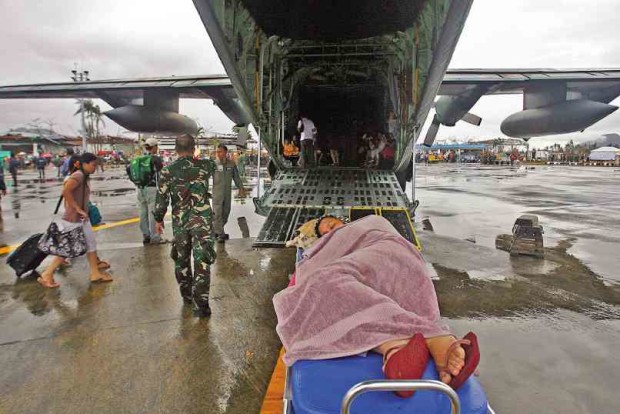‘Air ambulance’ gives poor a fighting chance

A WOMAN seeking medical attention waits to board a military C-130 plane as people were evacuated in Tacloban City after Supertyphoon “Yolanda” struck in 2013. The Philippine Air Force’s smaller aircraft, like helicopters, will again be tapped to bring patients in Southern Tagalog’s island provinces to hospitals in Metro Manila through a partnership with the Department of Health. RAFFY LERMA
A simple case of hernia cost the life of a poor man in Marinduque province in 2014.
That patient had to undergo surgery, but there was no transportation available to bring him to the nearest hospital in Lucena City, the provincial capital of Quezon, or Batangas province. He developed sepsis and died of infection.
This year, a 61-year-old employee of the Department of Health (DOH) acquired pneumonia while on field work in Romblon province. A diabetic, he had difficulty breathing and had to be put on a ventilator. He was evacuated from Tablas Island in Romblon but did not make it to the hospital in Metro Manila.
“Mobility has always been a problem,” said Eduardo Janairo, DOH director in Mimaropa (Mindoro, Marinduque, Romblon, Palawan). If only transportation were available, the patients may have had a chance to survive, he said.
Such instances drove a partnership between the DOH regional office and the Philippine Air Force (PAF) to use the government’s air assets to airlift patients, especially poor islanders who need “higher level” of medical attention in Metro Manila hospitals.
Article continues after this advertisementUnder the program, four helicopters of the PAF Special Operations Group have been made available since July to fly from Villamor Air Base in Pasay City and pick up patients on the islands. The DOH has tapped government hospitals in Metro Manila to receive the patients.
Article continues after this advertisement“The PAF is mandated [by law] to conduct airlifting during disasters. But this time, airlifting may be done for any patient even when there is no disaster, whether he is rich or poor,” Ramonito Martin of the DOH Health Emergency Management and Blood Services said in an interview on Monday.
Martin acknowledged that health facilities and personnel were not enough to address certain emergency cases in the provinces. Only 77 rural health units serve a population of more than 2.74 million (as of 2010) in the Mimaropa region.
The free air evacuation can reduce, for instance, an 11-hour travel by boat from Odiongan town in Romblon to a 45-minute flight to Quezon City.
A flight costs about P87,000 for aviation fuel and personnel.
The DOH regional office is allotting P1 million annually to shoulder the costs of the air ambulance. It has identified landing sites in parts of Palawan province, San Jose and Mamburao towns in Occidental Mindoro province, Calapan City in Oriental Mindoro province, Boac in Marinduque province, and Odiongan.
Janairo said the program would especially help members of indigenous communities.
The health regional office is also trying out motorcycle and tricycle ambulances to reach patients in far-flung villages.
It is working on partnerships with two nongovernment organizations that are willing to lend helicopters to the government in case of emergencies, Janairo said.